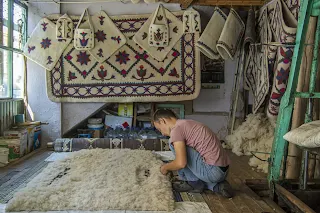With roots that go back centuries, the craft of wool felting is a traditional craft that embodies Morocco's ancient cultural heritage.
Mohammed Belkhou has been working with wool felt for 45 years. But his craft is threatened with extinction. And for good reason, it seems not to interest the new generation. But not only that, high-quality raw materials are becoming scarce.
"When we go to the market, we do not find wool in large quantities. This is because the wool sellers have also disappeared, due to lack of demand, and this is what we also suffer from, in addition to the fact that most of the artisans have died and young people are not interested in it because it is tiring," says the artisan.
In the face of these difficulties, efforts are being made to preserve the wool felt craft for future generations. The Moroccan Ministry of Tourism, Crafts and Social and Solidarity Economy has adopted a training program for young people.
''We brought in a craftsman and documented the production process from the beginning to the final product. We also organized training programs, according to new standards. Then, we tried to involve different actors from the public and private sectors in order to develop these trades and find a new function for them,'' explains Hicham Berdouzi, Regional Director of the Crafts Sector, Ministry of Tourism, Crafts and Social and Solidarity Economy.
As customers are scarce, artisans are trying to innovate. They draw on their ingenuity to offer new items. The price of wool felt items varies between $5 and $649.
"As demand has decreased, we thought of developing it. We now make bags, hats, necklaces and bracelets, and that is what tourists prefer," regrets Mohammed Belkhou, a wool felt craftsman:
Yet the work fascinates tourists like Jane. ''It's the first time I've come and I've never seen such crafts. They make hats, bags and lots of different things. It's really unusual and it's a very good craft, which takes a lot of time,'' explains the British woman.
The ministry hopes to protect the felt craft, not only to preserve cultural heritage, but also to support the local economy.




Informative
ReplyDeleteInformative
ReplyDeleteGood information
ReplyDeleteNice information
ReplyDeleteShocking
ReplyDeleteInformative
ReplyDeleteInformation
ReplyDeleteInformative
ReplyDeleteInformation
ReplyDeleteNice
ReplyDeleteAmezing
ReplyDeleteCool
ReplyDelete